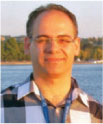How well can we predict and measure metal speciation in freshwaters?
John Hamilton-Taylor A B , Imad A. M. Ahmed A , William Davison A and Hao Zhang AA Lancaster Environment Centre (LEC), Lancaster University, Bailrigg, Lancaster LA1 4YQ, UK.
B Corresponding author. Email: j.hamilton-taylor@lancaster.ac.uk

John Hamilton-Taylor, a graduate of Swansea University (B.Sc.) and Edinburgh University (Ph.D. (Aquatic geochemistry)), has been a Reader in Aquatic Geochemistry at Lancaster University since 1995. His main interests relate to the biogeochemistry of metals and dissolved organic matter in aquatic, soil and sediment systems, and include studies of biogeochemical processes, element cycling and chemical speciation. |

Imad Ahmed is a graduate from Al Aqsa University, Palestine (B.Sc. (Physics and Chemistry)) and the University of Nottingham (M.Sc. and Ph.D. (Environmental Science)). In 2007, he moved to the School of Earth and Environment, Leeds University, to work as a postdoctoral research fellow. In 2009, he joined the Aquatic Chemistry team at the Lancaster Environment Centre as a Senior Research Associate. His research interests include the biogeochemical cycling of trace elements in natural waters and terrestrial environments. He is particularly interested in the development of new analytical methods and the application of synchrotron radiation-based spectroscopy and scattering methods to problems in geochemistry, environmental chemistry and solid state chemistry. |

Bill Davison has been Professor of Environmental Chemistry at the University of Lancaster for 20 years where his research has focussed on using diffusion gradients in thin-films to understand the dynamics of chemical speciation in solution and of solute–solid phase interactions in sediments and soils. Previously he was Head of Chemistry at the Institute for Freshwater Ecology where his research on biogeochemistry included redox-related processes in lakes. He is a graduate of the University of Newcastle upon Tyne (B.Sc. (Chemistry) and Ph.D. (Electrochemistry)) and has published more than 200 peer-reviewed papers. |

Hao Zhang is Reader in Environmental Chemistry and has 27 years of research experience in chemical speciation and biogeochemistry of trace metals in aquatic systems. After gaining her B.Sc. in Chemistry at the China Ocean University, Qingdao in 1984 she worked at the Oceanography Institute, the Chinese Academy of Sciences (1984–87), the University of Brussels (1987–91, Ph.D.), Liverpool University (1992) and Lancaster University (1993–present) where she has developed the diffusion gradients in thin-films technique and advanced understanding of biogeochemical processes affecting trace metals and other inorganic components in waters, sediments and soils. She has published more than 100 peer-reviewed papers. |
Environmental Chemistry 8(5) 461-465 https://doi.org/10.1071/EN11031
Submitted: 12 March 2011 Accepted: 27 May 2011 Published: 4 October 2011
Environmental context. The ‘speciation’ of metals is concerned with their different chemical and physical forms, a detailed knowledge of which is essential to understand what happens to metals in lakes and rivers, and their effects on living organisms. There have been many advances in recent years in our ability both to measure and predict metal speciation in natural waters, but it is not clear just how accurately these can be applied under field conditions. The current state of play is assessed to provide a better understanding of the related uncertainties, and suggestions are made for ways to reduce these uncertainties and possibly improve our predictive capabilities.
References
[1] J. G. Hering, Metal speciation and bioavailability: revisiting the ‘big questions’. Environ. Chem. 2009, 6, 290.| Metal speciation and bioavailability: revisiting the ‘big questions’.Crossref | GoogleScholarGoogle Scholar | 1:CAS:528:DC%2BD1MXhsVSlurfL&md5=568fae3961536541585667615eddad76CAS |
[2] R. E. Sturgeon, K. A. Francesconi, Enhancing reliability of elemental speciation results – quo vadis? Environ. Chem. 2009, 6, 294.
| Enhancing reliability of elemental speciation results – quo vadis?Crossref | GoogleScholarGoogle Scholar | 1:CAS:528:DC%2BD1MXhsVSlurfE&md5=48786a42df8a4191df1eda6e1e093c6fCAS |
[3] D. M. Di Toro, H. E. Allen, H. L. Bergman, J. S. Meyer, P. R. Paquin, R. C. Santore, Biotic ligand model of the acute toxicity of metals. 1. Technical basis. Environ. Toxicol. Chem. 2001, 20, 2383.
| Biotic ligand model of the acute toxicity of metals. 1. Technical basis.Crossref | GoogleScholarGoogle Scholar | 1:CAS:528:DC%2BD38XitlWnuw%3D%3D&md5=98ac74875b8364d484a1bf8d1a2dd7c9CAS |
[4] R. C. Santore, D. M. Di Toro, P. R. Paquin, H. E. Allen, J. S. Meyer, Biotic ligand model of the acute toxicity of metals. 2. Application to acute copper toxicity in freshwater fish and Daphnia. Environ. Toxicol. Chem. 2001, 20, 2397..
[5] Aquatic Life Ambient Freshwater Quality Criteria – Copper 2007 (USEPA). Available at http://www.epa.gov/waterscience/criteria/copper/2007/criteria200702.pdf [Verified 1 September 2011].
[6] M. Vangheluwe, P. van Sprang, F. Verdonck, D. Heijerick, B. Versonnen, M. Vandenbroele, A. Van Hyfte, MERAG: Metals Environmental Risk Assessment Guidance 2007 (ICMM: London).
[7] E. Tipping, WHAM – a chemical equilibrium model and computer code for waters, sediments, and soils incorporating a discrete site/electrostatic model of ion binding by humic-substances. Comput. Geosci. 1994, 20, 973.
| WHAM – a chemical equilibrium model and computer code for waters, sediments, and soils incorporating a discrete site/electrostatic model of ion binding by humic-substances.Crossref | GoogleScholarGoogle Scholar | 1:CAS:528:DyaK2MXhtlyhtrY%3D&md5=ff1fad234a23210b70b4a7a0af81dbebCAS |
[8] E. Tipping, Humic ion-binding Model VI: an improved description of the interactions of protons and metal ions with humic substances. Aquat. Geochem. 1998, 4, 3.
| Humic ion-binding Model VI: an improved description of the interactions of protons and metal ions with humic substances.Crossref | GoogleScholarGoogle Scholar | 1:CAS:528:DyaK1cXntlSjuro%3D&md5=b691b52d3cb423544a67e094a347a8e7CAS |
[9] M. F. Benedetti, C. J. Milne, D. G. Kinniburgh, W. H. Van Riemsdijk, L. K. Koopal, Metal-ion binding to humic substances – application of the nonideal competitive adsorption model. Environ. Sci. Technol. 1995, 29, 446.
| Metal-ion binding to humic substances – application of the nonideal competitive adsorption model.Crossref | GoogleScholarGoogle Scholar | 1:CAS:528:DyaK2MXivFOrs7s%3D&md5=de4e511b12fb5464799071744f2c0345CAS |
[10] D. G. Kinniburgh, W. H. vanRiemsdijk, L. K. Koopal, M. Borkovec, M. F. Benedetti, M. J. Avena, Ion binding to natural organic matter: competition, heterogeneity, stoichiometry and thermodynamic consistency. Colloids Surf. A 1999, 151, 147.
| Ion binding to natural organic matter: competition, heterogeneity, stoichiometry and thermodynamic consistency.Crossref | GoogleScholarGoogle Scholar | 1:CAS:528:DyaK1MXhvV2ns7g%3D&md5=4d6a0cecf96f67019e05ce465c99a2f8CAS |
[11] E. Tipping, C. Rey-Castro, S. E. Bryan, J. Hamilton-Taylor, AlIII and FeIII binding by humic substances in freshwaters, and implications for trace metal speciation. Geochim. Cosmochim. Acta 2002, 66, 3211.
| AlIII and FeIII binding by humic substances in freshwaters, and implications for trace metal speciation.Crossref | GoogleScholarGoogle Scholar | 1:CAS:528:DC%2BD38XmslKktbk%3D&md5=a25ce479a1d5c2747391b029a1720eccCAS |
[12] H. P. van Leeuwen, R. M. Town, Kinetic limitations in measuring stabilities of metal complexes by competitive ligand exchange–adsorptive stripping voltammetry (CLE-AdSV). Environ. Sci. Technol. 2005, 39, 7217.
| Kinetic limitations in measuring stabilities of metal complexes by competitive ligand exchange–adsorptive stripping voltammetry (CLE-AdSV).Crossref | GoogleScholarGoogle Scholar | 1:CAS:528:DC%2BD2MXns1aisLk%3D&md5=e4d1bfed3c607ae97e29f79a972d84f9CAS |
[13] L. Sigg, F. Black, J. Buffle, J. Cao, R. Cleven, W. Davison, J. Galceran, P. Gunkel, E. Kalis, D. Kistler, M. Martin, S. Noel, Y. Nur, N. Odzak, J. Puy, W. Van Riemsdijk, E. Temminghoff, M. L. Tercier-Waeber, S. Toepperwien, R. M. Town, E. R. Unsworth, K. W. Warnken, L. P. Weng, H. B. Xue, H. Zhang, Comparison of analytical techniques for dynamic trace metal speciation in natural freshwaters. Environ. Sci. Technol. 2006, 40, 1934.
| Comparison of analytical techniques for dynamic trace metal speciation in natural freshwaters.Crossref | GoogleScholarGoogle Scholar | 1:CAS:528:DC%2BD28Xht1yhsLk%3D&md5=0e79db7e4260d6d64133ebab749fe880CAS |
[14] E. R. Unsworth, K. W. Warnken, H. Zhang, W. Davison, F. Black, J. Buffle, J. Cao, R. Cleven, J. Galceran, P. Gunkel, E. Kalis, D. Kistler, H. P. Van Leeuwen, M. Martin, S. Noel, Y. Nur, N. Odzak, J. Puy, W. Van Riemsdijk, L. Sigg, E. Temminghoff, M. L. Tercier-Waeber, S. Toepperwien, R. M. Town, L. P. Weng, H. B. Xue, Model predictions of metal speciation in freshwaters compared to measurements by in situ techniques. Environ. Sci. Technol. 2006, 40, 1942.
| Model predictions of metal speciation in freshwaters compared to measurements by in situ techniques.Crossref | GoogleScholarGoogle Scholar | 1:CAS:528:DC%2BD28XhtlSku7o%3D&md5=0fb2b12c18be39d9d0d730904acfe0baCAS |
[15] K. W. Warnken, A. J. Lawlor, S. Lofts, E. Tipping, W. Davison, H. Zhang, In situ speciation measurements of trace metals in headwater streams. Environ. Sci. Technol. 2009, 43, 7230.
| In situ speciation measurements of trace metals in headwater streams.Crossref | GoogleScholarGoogle Scholar | 1:CAS:528:DC%2BD1MXmsFGlsbw%3D&md5=5279973468e023cc1a518bfd28100f47CAS |
[16] E. Tipping, Cation binding by humic substances 2002 (Cambridge University Press: Cambridge, UK).
[17] H. Xue, L. Sigg, Comparison of the complexation of Cu and Cd by humic and fulvic acids and by ligands observed in lake waters. Aquat. Geochem. 1999, 5, 313.
| Comparison of the complexation of Cu and Cd by humic and fulvic acids and by ligands observed in lake waters.Crossref | GoogleScholarGoogle Scholar | 1:CAS:528:DC%2BD3cXivVCmtw%3D%3D&md5=cede0cb071b74a94db784790604f9bd1CAS |
[18] F. C. Wu, E. Tanoue, Isolation and partial characterization of dissolved copper-complexing ligands in streamwaters. Environ. Sci. Technol. 2001, 35, 3646.
| Isolation and partial characterization of dissolved copper-complexing ligands in streamwaters.Crossref | GoogleScholarGoogle Scholar | 1:CAS:528:DC%2BD3MXlslyksrg%3D&md5=c0302d093a4da93f7c278375a2487536CAS |
[19] B. Nowack, H. B. Xue, L. Sigg, Influence of natural and anthropogenic ligands on metal transport during infiltration of river water to groundwater. Environ. Sci. Technol. 1997, 31, 866.
| Influence of natural and anthropogenic ligands on metal transport during infiltration of river water to groundwater.Crossref | GoogleScholarGoogle Scholar | 1:CAS:528:DyaK2sXotVahtQ%3D%3D&md5=503c58ccda25edb63de9ee76dccc42a1CAS |
[20] H.-B. Xue, L. Sigg, F. G. Karl, Speciation of EDTA in natural waters: exchange kinetics of Fe-EDTA in river water. Environ. Sci. Technol. 1995, 29, 59.
| Speciation of EDTA in natural waters: exchange kinetics of Fe-EDTA in river water.Crossref | GoogleScholarGoogle Scholar | 1:CAS:528:DyaK2MXisVyntLk%3D&md5=0487f8bca6de9aa1f74fac07f7894f60CAS |
[21] E. J. J. Kalis, L. P. Weng, F. Dousma, E. J. M. Temminghoff, W. H. Van Riemsdijk, Measuring free metal ion concentrations in situ in natural waters using the Donnan membrane technique. Environ. Sci. Technol. 2006, 40, 955.
| Measuring free metal ion concentrations in situ in natural waters using the Donnan membrane technique.Crossref | GoogleScholarGoogle Scholar | 1:CAS:528:DC%2BD2MXhtlars7rK&md5=34b646739eecb63e5febbd1e42ffae9dCAS |
[22] A. Stockdale, E. Tipping, S. Lofts, S. J. Ormerod, W. H. Clements, R. Blust, Toxicity of proton–metal mixtures in the field: linking stream macroinvertebrate species diversity to chemical speciation and bioavailability. Aquat. Toxicol. 2010, 100, 112.
| Toxicity of proton–metal mixtures in the field: linking stream macroinvertebrate species diversity to chemical speciation and bioavailability.Crossref | GoogleScholarGoogle Scholar | 1:CAS:528:DC%2BC3cXhtFGjurbM&md5=d237a544d22721cc6fae67c990d5b3b1CAS |
[23] S. Lofts, D. J. Spurgeon, C. Svendsen, E. Tipping, Deriving soil critical limits for Cu, Zn, Cd, and Ph: a method based on free ion concentrations. Environ. Sci. Technol. 2004, 38, 3623.
| Deriving soil critical limits for Cu, Zn, Cd, and Ph: a method based on free ion concentrations.Crossref | GoogleScholarGoogle Scholar | 1:CAS:528:DC%2BD2cXktlymurw%3D&md5=d39c91f2e2647a8cfcb98e42df6c4409CAS |
[24] E. Tipping, J. J. Rothwell, L. Shotbolt, A. J. Lawlor, Dynamic modelling of atmospherically deposited Ni, Cu, Zn, Cd and Pb in Pennine catchments (northern England). Environ. Pollut. 2010, 158, 1521.
| Dynamic modelling of atmospherically deposited Ni, Cu, Zn, Cd and Pb in Pennine catchments (northern England).Crossref | GoogleScholarGoogle Scholar | 1:CAS:528:DC%2BC3cXmt1Kmsro%3D&md5=05abbd198c89fdcdef1c63703a271723CAS |
[25] E. Tipping, C. D. Vincent, A. J. Lawlor, S. Lofts, Metal accumulation by stream bryophytes, related to chemical speciation. Environ. Pollut. 2008, 156, 936.
| Metal accumulation by stream bryophytes, related to chemical speciation.Crossref | GoogleScholarGoogle Scholar | 1:CAS:528:DC%2BD1cXhsVSgtb3J&md5=b7c71a1ee37d4f9ae78fa5cacce0b667CAS |
[26] S. Lofts, E. Tipping, J. Hamilton-Taylor, The chemical speciation of FeIII in freshwaters. Aquat. Geochem. 2008, 14, 337.
| The chemical speciation of FeIII in freshwaters.Crossref | GoogleScholarGoogle Scholar | 1:CAS:528:DC%2BD1cXht12gtLzN&md5=f58811c57a05d7bc8eefbd42797526e4CAS |
[27] M. H. Tusseau-Vuillemin, R. Gilbin, E. Bakkaus, J. Garric, Performance of diffusion gradient in thin films to evaluate the toxic fraction of copper to Daphnia magna. Environ. Toxicol. Chem. 2004, 23, 2154.
| Performance of diffusion gradient in thin films to evaluate the toxic fraction of copper to Daphnia magna.Crossref | GoogleScholarGoogle Scholar | 1:CAS:528:DC%2BD2cXms1GhsLk%3D&md5=619ab285ba6d363697ce0bc71e9afcdcCAS |
[28] P. Bradac, R. Behra, L. Sigg, Accumulation of cadmium in periphyton under various freshwater speciation conditions. Environ. Sci. Technol. 2009, 43, 7291.
| Accumulation of cadmium in periphyton under various freshwater speciation conditions.Crossref | GoogleScholarGoogle Scholar | 1:CAS:528:DC%2BD1MXpslClt74%3D&md5=fd62057e0f46805ff960abeeddff1aadCAS |
[29] W. Davison, H. Zhang, In situ speciation measurement of trace components in natural waters using thin-film gels. Nature 1994, 367, 546.
| In situ speciation measurement of trace components in natural waters using thin-film gels.Crossref | GoogleScholarGoogle Scholar | 1:CAS:528:DyaK2cXhsVemtrc%3D&md5=1fcb8f1595dfa1f204ca74bafaf9259aCAS |
[30] H. Zhang, W. Davison, Performance-characteristics of diffusion gradients in thin films for the in-situ measurement of trace metals in aqueous solution. Anal. Chem. 1995, 67, 3391.
| Performance-characteristics of diffusion gradients in thin films for the in-situ measurement of trace metals in aqueous solution.Crossref | GoogleScholarGoogle Scholar | 1:CAS:528:DyaK2MXnslKgtrc%3D&md5=87242e0da4eca5a0b457f07f56562955CAS |
[31] M. L. Tercier, J. Buffle, Antifouling membrane-covered voltammetric microsensor for in situ measurements in natural waters. Anal. Chem. 1996, 68, 3670.
| Antifouling membrane-covered voltammetric microsensor for in situ measurements in natural waters.Crossref | GoogleScholarGoogle Scholar | 1:CAS:528:DyaK28XlsVymsrw%3D&md5=cfe26aefa5a048843f6f68d084e298e4CAS |
[32] C. Belmont-Hébert, M. L. Tercier, J. Buffle, G. C. Fiaccabrino, N. F. de Rooij, M. Koudelka-Hep, Gel-integrated microelectrode arrays for direct voltammetric measurements of heavy metals in natural waters and other complex media. Anal. Chem. 1998, 70, 2949.
| Gel-integrated microelectrode arrays for direct voltammetric measurements of heavy metals in natural waters and other complex media.Crossref | GoogleScholarGoogle Scholar |
[33] M. L. Tercier-Waeber, J. Buffle, M. Koudelka-Hep, F. Graziottin, Submersible voltammetric probes for real-time continuous monitoring of trace elements in natural aquatic systems, in Environmental Electrochemistry (Eds M. Taillefert, T. F. Rozan) 2002, pp. 16–39 (American Chemical Society: Washington, DC).
[34] E. J. M. Temminghoff, A. C. C. Plette, R. Van Eck, W. H. Van Riemsdijk, Determination of the chemical speciation of trace metals in aqueous systems by the Wageningen Donnan membrane technique. Anal. Chim. Acta 2000, 417, 149.
| Determination of the chemical speciation of trace metals in aqueous systems by the Wageningen Donnan membrane technique.Crossref | GoogleScholarGoogle Scholar | 1:CAS:528:DC%2BD3cXkslWlsb8%3D&md5=6e1a4f945d50d431a5aed1cf42c4bc9bCAS |
[35] L. P. Weng, W. H. Van Riemsdijk, E. J. M. Temminghoff, Kinetic aspects of Donnan membrane technique for measuring free trace cation concentration. Anal. Chem. 2005, 77, 2852.
| Kinetic aspects of Donnan membrane technique for measuring free trace cation concentration.Crossref | GoogleScholarGoogle Scholar | 1:CAS:528:DC%2BD2MXislWmur8%3D&md5=4435ecf0b550c95c4fd3ba1bf7af7b07CAS |
[36] N. Parthasarathy, M. Pelletier, J. Buffle, Hollow fibre based supported liquid membrane: a novel analytical system for trace metal analysis. Anal. Chim. Acta 1997, 350, 183.
| Hollow fibre based supported liquid membrane: a novel analytical system for trace metal analysis.Crossref | GoogleScholarGoogle Scholar | 1:CAS:528:DyaK2sXlsVWgt70%3D&md5=8611a968c3b9181a1a74adb0bdd041e5CAS |
[37] J. Buffle, N. Parthasarathy, N. K. Djane, L. Matthiasson, Permeation liquid membrane for field analysis and speciation of trace compounds in waters, in In Situ Monitoring of Aquatic Systems, Chemical Analysis and Speciation (Eds J. Buffle, G. Horvai) 2000, pp. 407–493 (Wiley: Chichester, UK).
[38] C. Fortin, Y. Couillard, B. Vigneault, P. G. C. Campbell, Determination of free Cd, Cu and Zn concentrations in lake waters by in situ diffusion followed by column equilibration ion-exchange. Aquat. Geochem. 2010, 16, 151.
| Determination of free Cd, Cu and Zn concentrations in lake waters by in situ diffusion followed by column equilibration ion-exchange.Crossref | GoogleScholarGoogle Scholar | 1:CAS:528:DC%2BD1MXhsFyjt7rN&md5=3772709bab6fd64af7f601da71a11dc3CAS |


